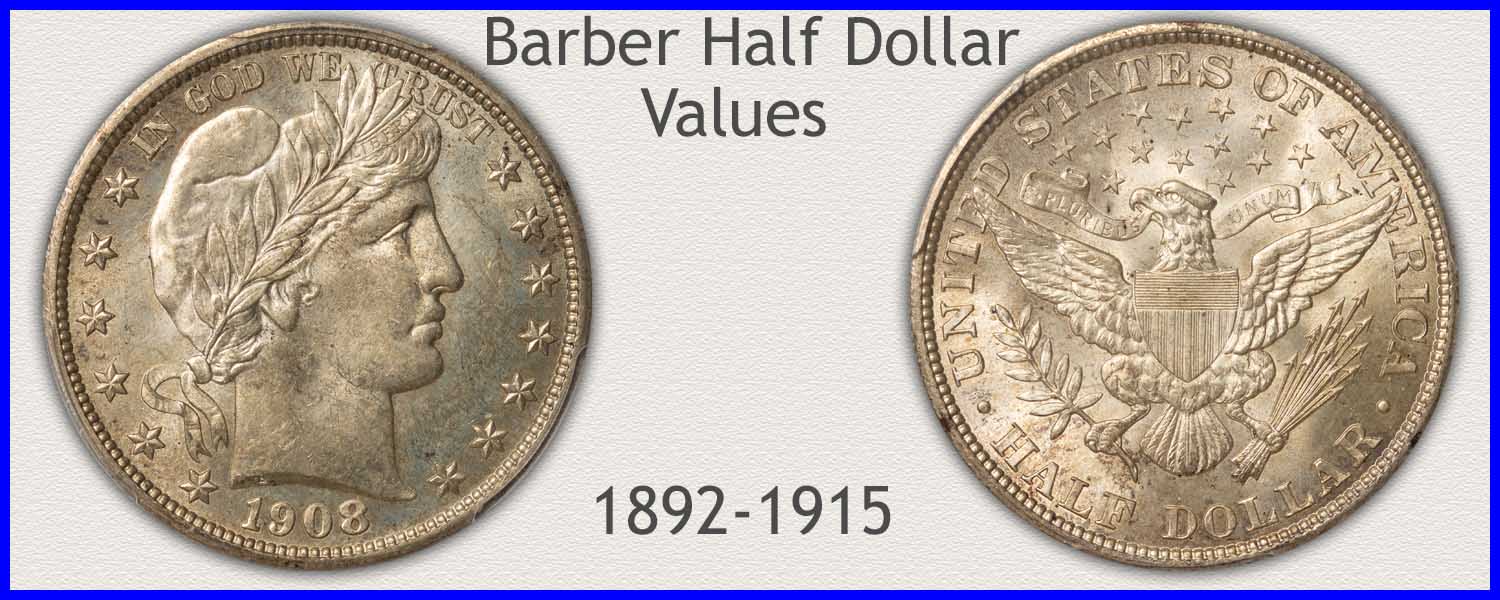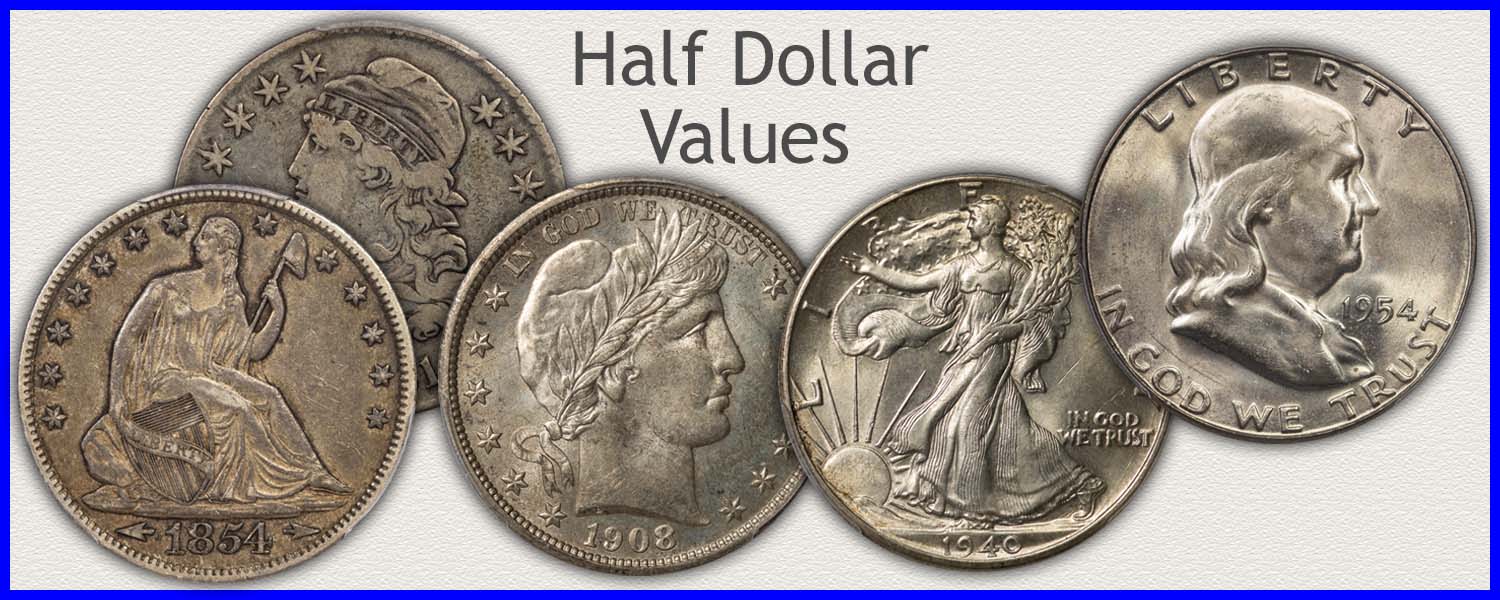Coin Values Moving with Precious Metals: Up-Dated 12/22/2025: Gold $4413 | Silver $68.92
1911 Half Dollar Value
1911 half dollar value for examples in above average condition is strongly higher than the minimum base worth of $39.03 each. The availability of collector-quality pieces is quite limited.
As seen on the chart, note the value difference between each grade level. A step-by-step process is used to recognize significant characteristics, defining where your coin appears on the chart.
Compare your half dollar to a series of grading images after confirming the date and mint combination.
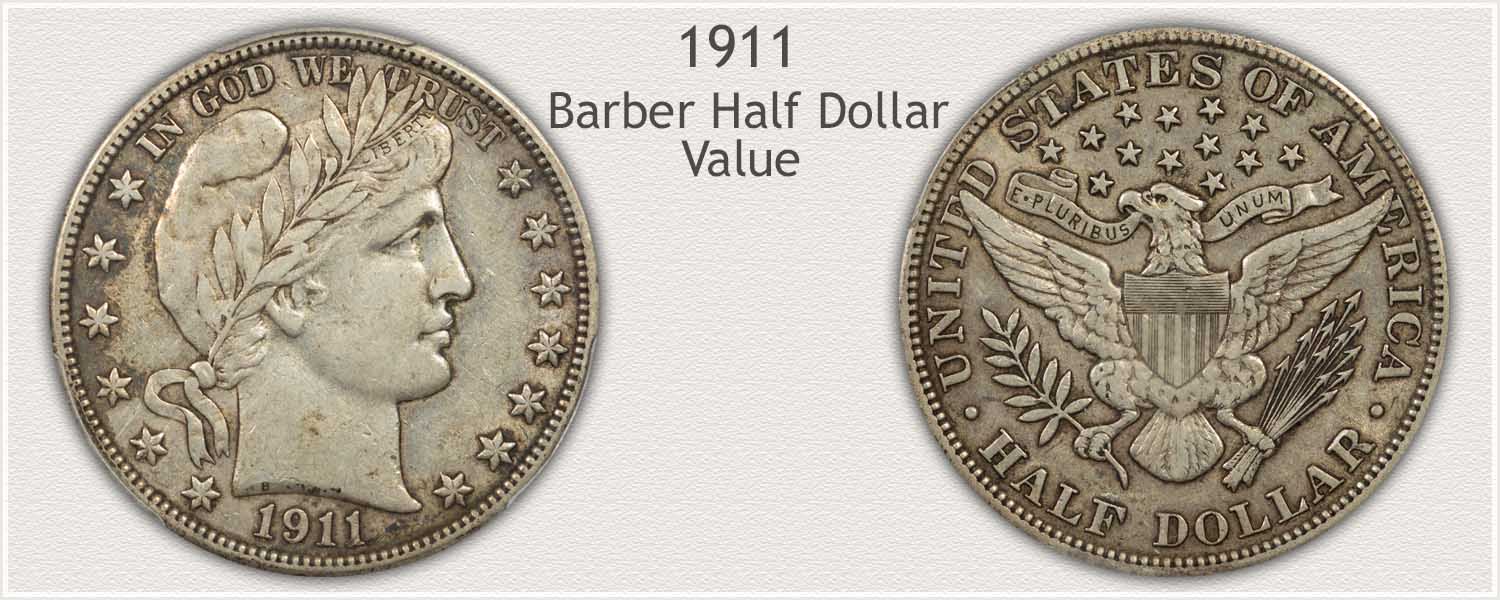
Steps Leading to Value:
- Step 1: Date and Mintmark Variety - It is important to identify both the date and the mint variety of these old halves. Three mints created 1911 half dollars.
- Step 2: Grading Condition - Among dealers and collectors, a coin's grade describes its condition. A series of grades are depicted by the images in Step 2.
- Step 3: Special Qualities - Identifying a quality example finds a coin in demand. Collectors seek lightly worn or superior coins with visual appeal. Proper storage and handling preserve value.
| 1911 Half Dollar Value | ||||
|---|---|---|---|---|
| Condition of Coin | ||||
| Date | Good | Fine | Extremely Fine | Mint State |
| Barber Half Dollar Values Updated | 12/22/2025 | |||
| 1911 | $39.03 | $56 | $145 | $434 |
| 1911 D | $39.03 | $73 | $228 | $396 |
| 1911 S | $41.05 | $55 | $188 | $783 |
Use the values listed as a guide and a starting point when determining the wholesale worth of Barber half dollars. Add the steps below to narrow their range.
Step 1: | Confirm Date and Mint Combination
Three Date and Mint Combinations of 1911 Half Dollars
The mint in Philadelphia was the primary source for 1911 half dollars. Additionally, the branch mint in Denver contributed coinage to the series as well, but at far fewer numbers.
Collectors place importance on completing collections that include all date and mint issues. It is necessary to identify these different mints. Reference the images below highlighting mintmarks used to identify the different mints.
1911-S Barber Half Dollar
"S" Mintmark on Reverse: San Francisco Mint Struck the Coin
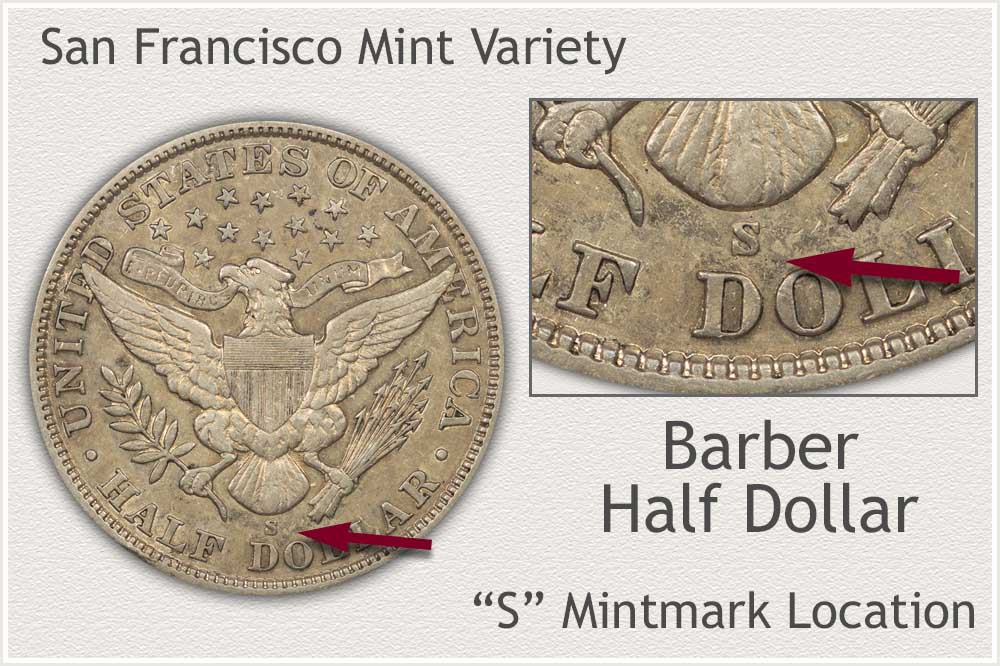
San Francisco mint half dollars struck in 1911 are all at a premium because of silver content. With collectors looking for nice, well-detailed examples, Western Branch Mint coins are a popular variety. There were just over 1.2 million produced, and low condition examples remain available today. The situation is entirely different when collectors seek higher quality. Lightly worn or better quality examples are an elusive coin. Demand for those of collectible quality is high.
San Francisco half dollars are recognized by the "S" mintmark located on the reverse. A "S" mintmark is found in the lower portion of the coin, just below the Eagle's tail feathers. This "S" serves as an indicator of the mint.
1911-D Barber Half Dollar
"D" Mintmark on Reverse: Denver Mint Struck the Coin
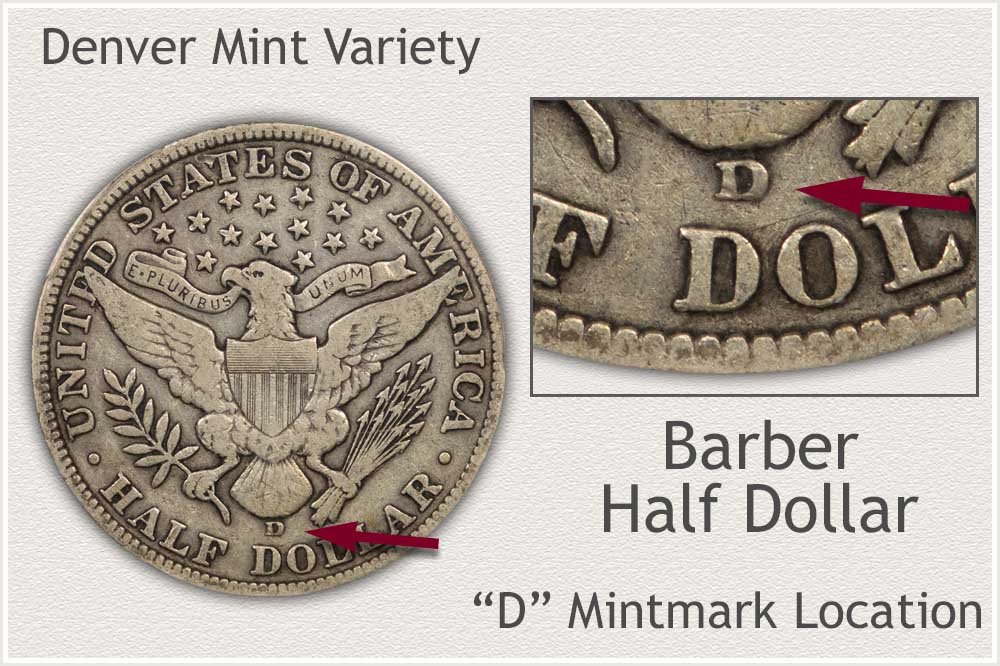
After a two-year absence in half dollar production, the Denver mint struck in 1911 what has become an interesting coin to collectors today. These halves are notable for their very low mintage, just 695,080 produced, and secondly, they remain affordable to many collectors. A mintage of under one million and enough available to supply collectors of all budgets. A very desirable coin.
Denver is a branch mint, and required place a mintmark on its coinage. Location of the mintmark is on the reverse, just above the "DO" letters of "DOLLAR". This large "D" confirms this highly collectible and premium Barber half dollar.
1911 Barber Half Dollar
No Mintmark on Reverse: Philadelphia Mint Struck the Coin
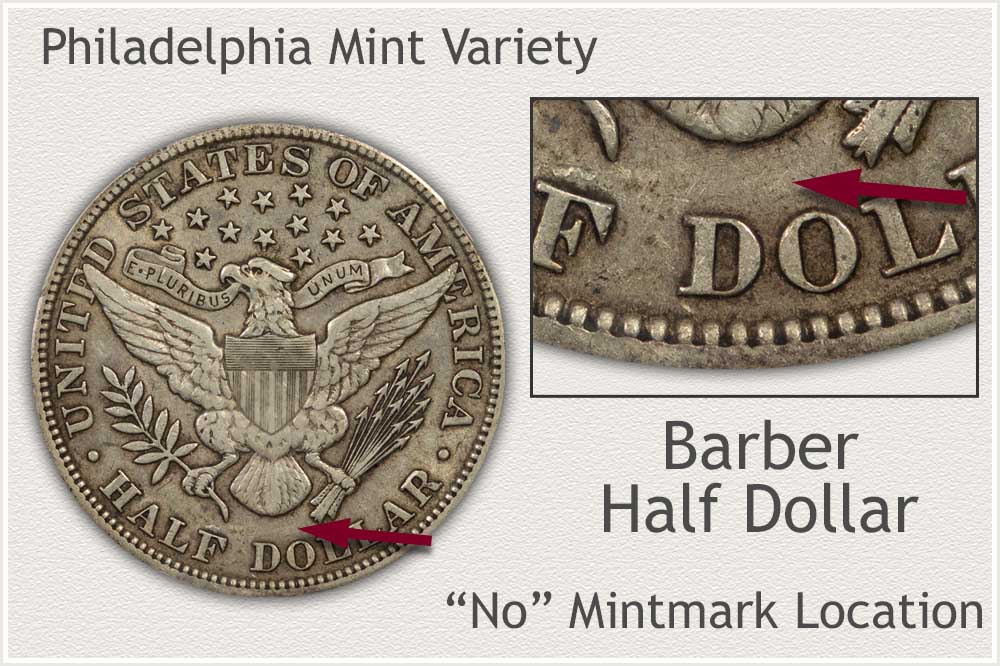
The primary mint in Philadelphia produced what became an average amount of half dollars in 1911, towards the latter year of the series. Just over 1.4 million pieces were produced in total by the ending of the year. Silver content of 90% by weight plus premiums rise when the coin's condition is above average contribute to their value.
Additionally, it has the notoriety of the now long-ago Barber series of half dollars and remains affordable in lower grades of condition. Heavy silver content, historical, and obtainable leads to a favorite coin with new collectors.
Absence of a mintmark on the reverse verifies the coin is of the Philadelphia variety. At the time, Philadelphia, the first U.S. mint, did not use mintmarks on coinage. On the reverse, examine the area immediately below the eagle. An empty space indicates the coin was struck in Philadelphia.
Step 2: | Grading Defines Quality and Collectible Status
Small Details Visible Help Determine 1911 Half Dollar Value
Collectible, coins are judged and "graded" as part of a process to define their surface condition. 1911 is a date the majority of coins found today are heavily worn. Detecting higher quality finds the premium examples worth well above base silver value.
These grades categorize stages of wear, and the grading term is used as a description by collectors when referencing condition. Features of the design wear in recognizable stages over time, and indicators such as flattened areas and blending of small design elements are noted, helping identify these stages of wear. Magnification aids in recognizing the smaller, subtle differences found on the coin during the grading process.
Mint State Grade
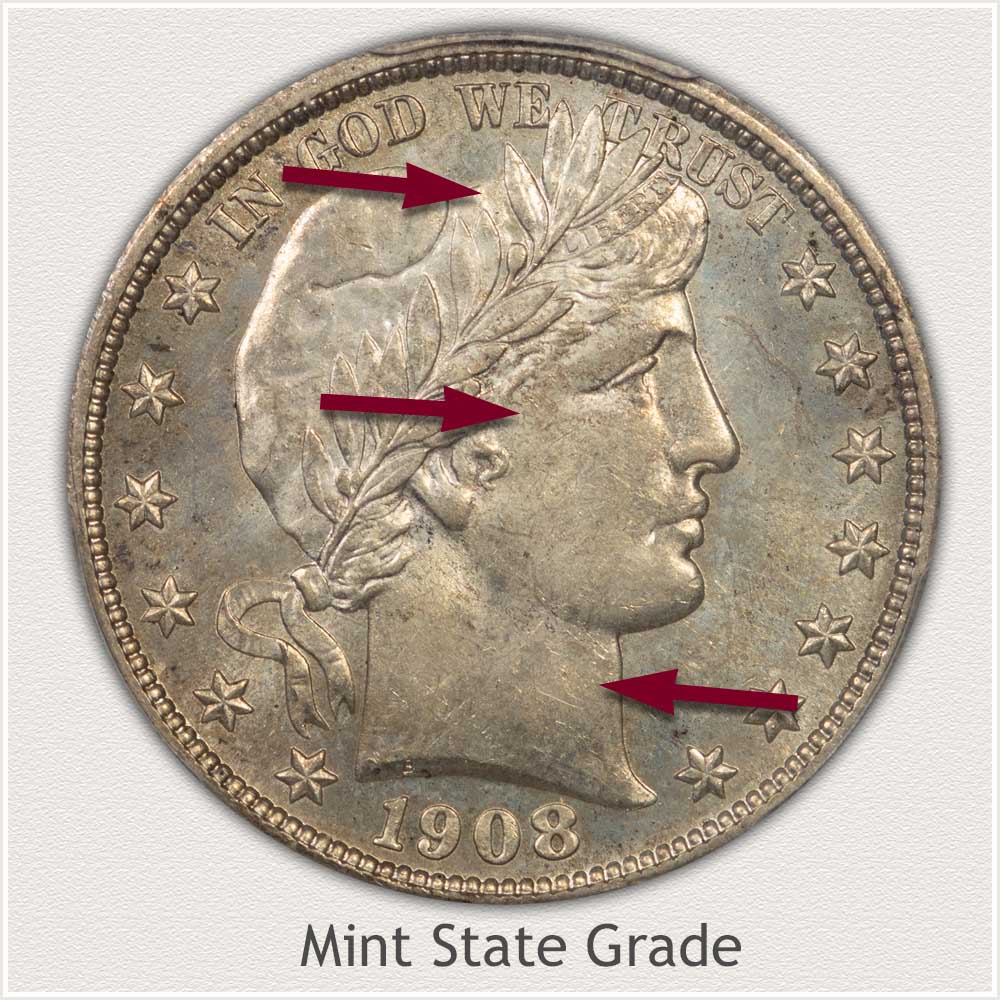
Mint State: A huge jump in both rarity and price occurs when a Barber half dollar is judged as Mint State condition. A coin is considered mint state if the surface has not been worn. Examining a few crucial areas, such as Liberty's face, the wreath's leaves, and her cap, is used in judging its condition.
Silver has a fine texture of luster when it is first minted, which radiates as light passes over the surface. This fine luster grain is fragile and deteriorates quickly. On a Barber half dollar, the covering of luster is still present in areas of Liberty's cheek that are high profile. Comparing her cheeks to her neck, another area prone to wear, notice the appearance is similar. Similarly, the cheek and neck areas of mint state coins are comparable in shine and texture to the lower relief areas, particularly the area along the jaw line.
With wear, the metal's surface becomes smoother, and its color changes from brilliant silver-white to gray. Next, judge the laurel wreath's leaves, a delicate detail that easily shows wear and smoothing. Overall, the leaves are still fully lustrous, have high points, and remain with raised edges. Verify that all exposed areas of Liberty's cap retain their luster, the metal has not dulled, and compares well to her cheek and neck. Under a single light, carefully tilt the coin to see the luster moving continuously across its surface.
Extremely Fine Grade
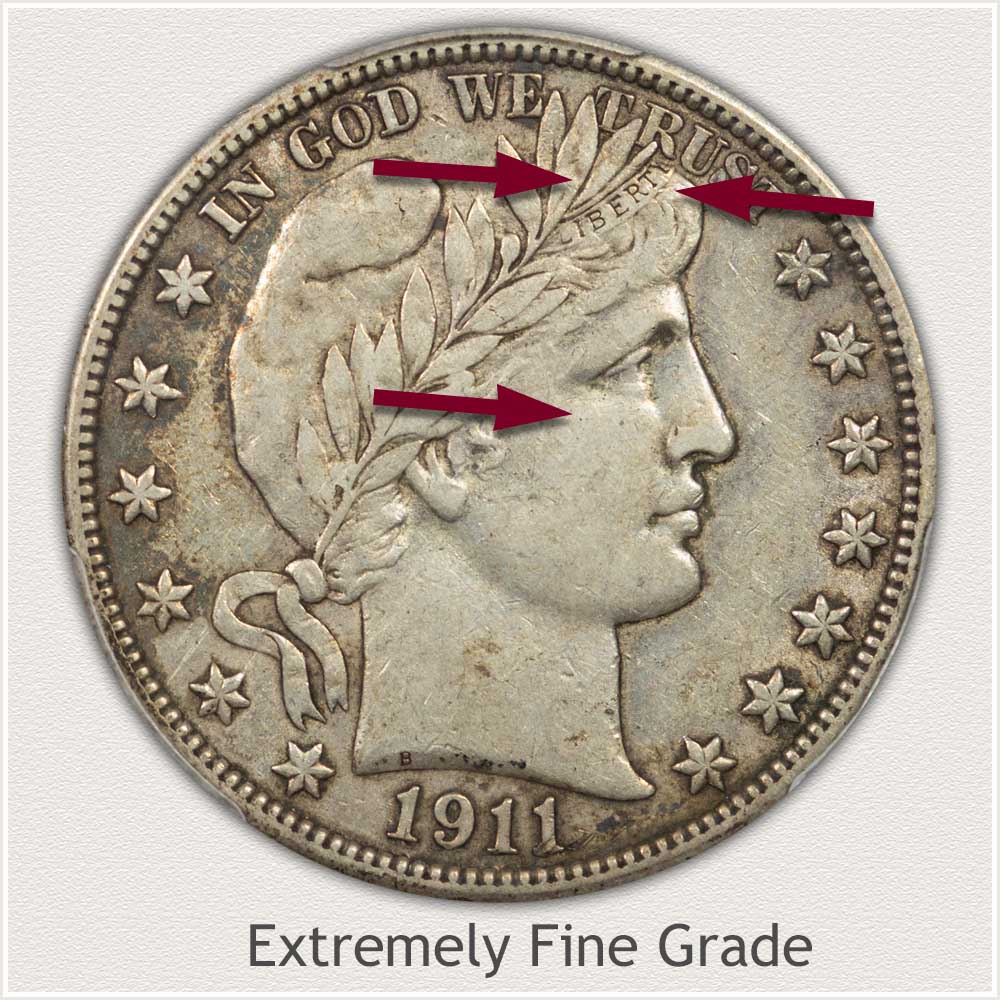
Extremely Fine: Identifying a Barber half with very fine details visible identifies a collectible quality coin. A grade of Extremely Fine defines and describes a coin with only light wear restricted to small areas.
A lightly circulated half dollar has a soft silver-gray color overall, replacing most of the original luster's brilliance. The surface of the metal now has a smooth texture. Liberty's headband clearly displays the word "LIBERTY" in its entirety, with all letters bold and visible. Importantly, there is still a distinct edge to the headband, both just above and just below the lettering. The borders of this band remain clear and separate of the hair and leaves.
All high and low relief areas of Liberty's full portrait are defined, enhancing its appeal to collectors. Her cheek and neck show minor smoothing, and her eyebrow is the only area slightly flattened. When these coins appear well detailed, they are strongly considered for the grade of Extremely Fine.
Fine Grade
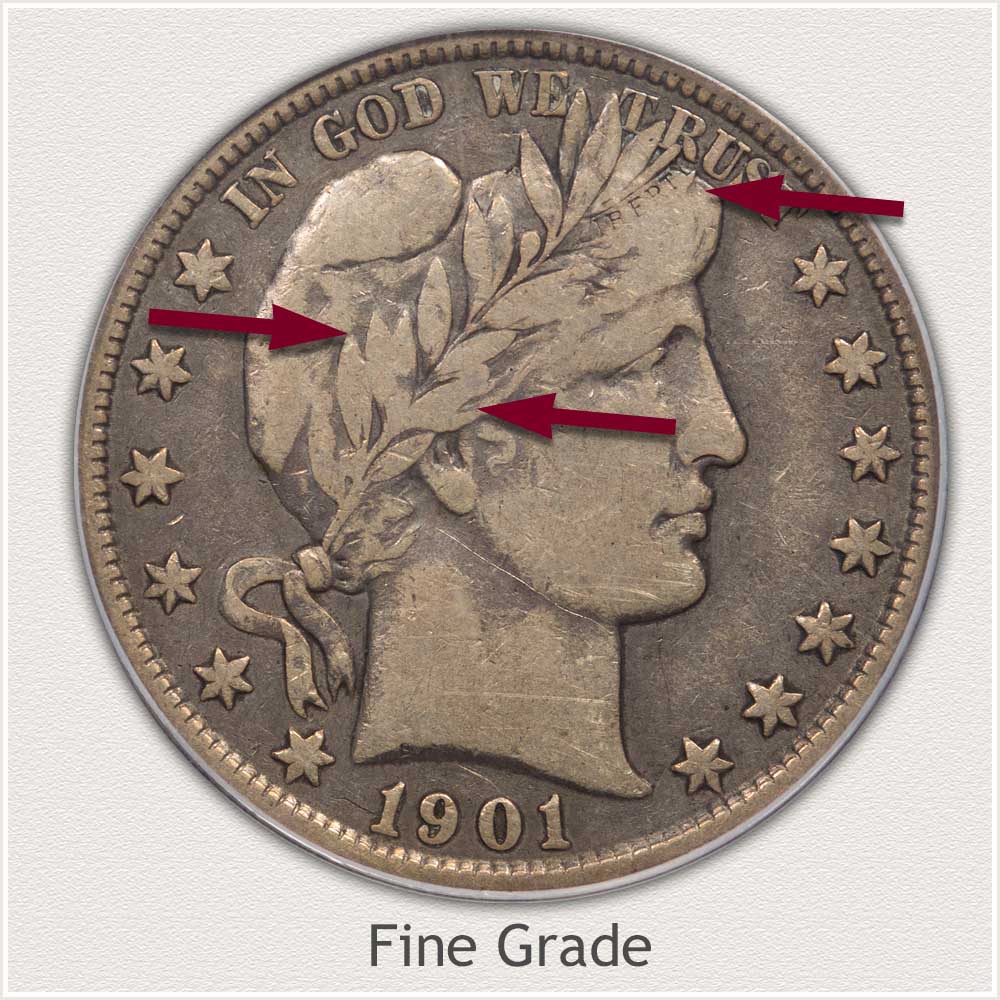
Fine Grade: New collectors of the series often consider Barber halves in Fine grade as an affordable coin to add to their collections. This grade is defined as showing only moderate wear with many fine details visible. Detail on coins in this condition is still quite extensive. As example: recognizable lettering within the headband, and a wreath with clearly visible leaves.
The upper leaves of the wreath remain visible and outlined in order to receive the Fine grade. Notable on the upper row are the two leaves closest to the ear, and those just above are blended slightly where they overlap. Significant to the grade, the example half is well within the grade due to a lack of detail in the lower leaves. Also, the lower leaves' distinctive edges have worn and disappeared, blending with Liberty's hair.
One of the most important features of her headband is the easily recognizable letters "LIBERTY." There is only fading along the lower area, and all letters remain identifiable. On the Barber design, the letters are deeply impressed at this highest point of relief. These letters' lack of detail indicates that a significant amount of metal has been worn away. A coin with many details clearly visible, only slight flattening to open areas such as her cheek and neck, and a bold date and rim, qualifies as Fine grade condition.
Good Grade
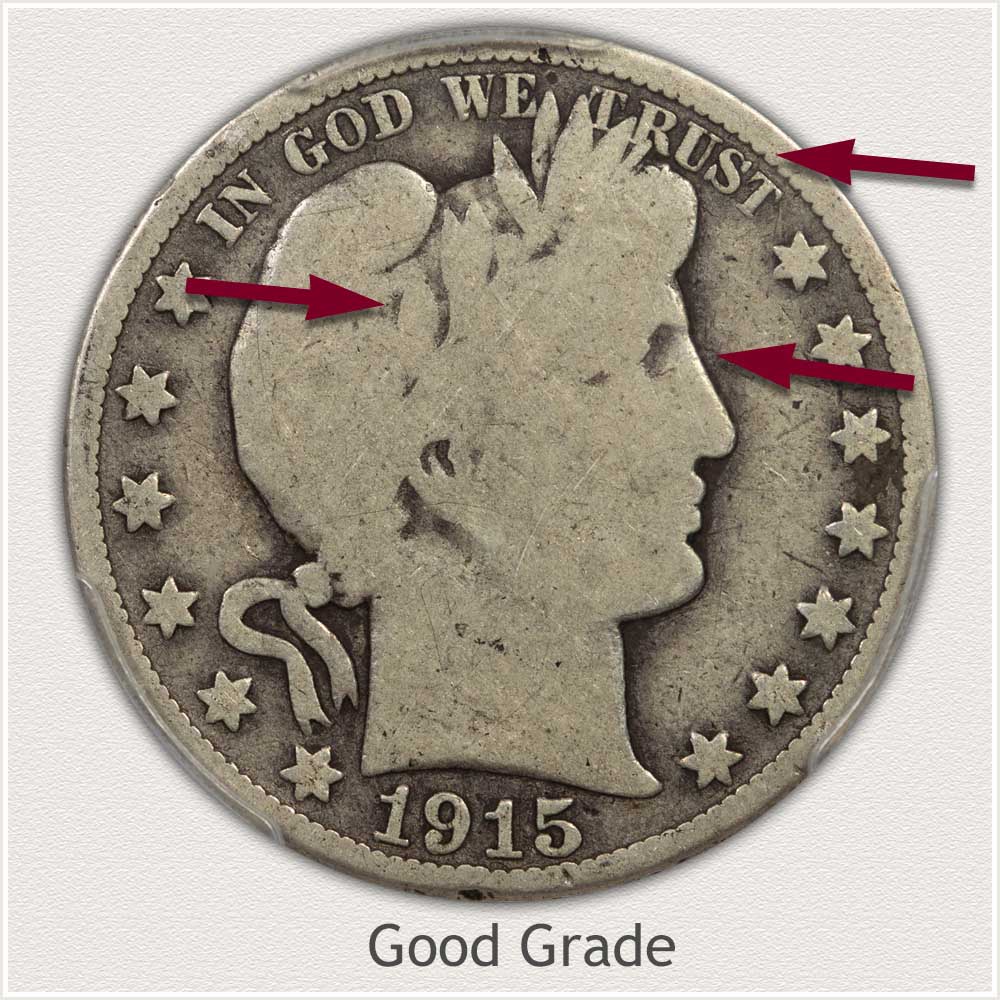
Good Grade: A half dollar graded "Good" has characteristics adding to the appeal of the coin despite its degree of wear. The definition of the Good grade is the portrait of Liberty is worn smooth, with only a few of the central design elements remaining.
Note a small amount of wreath detail is often visible. Partial leaf detail remaining along the bottom of her cap places the coin above severely worn examples.
In this grade, collectors seek coins with a complete rim and no merging with stars or lettering. Even though her hairline above her forehead is smooth, the remaining detail of the eye and ear are important in determining the condition and final grade. The overall design is highlighted and given a sharp appearance by the metal's subtle toning. A pleasing coin, popular with new collectors.
How to Video: Grading Barber Half Dollars
Increase accuracy judging condition and recognizing higher quality. Subtle points are examined in detail.
Video, Images and Descriptions | Grading Barber Half Dollars
Step 3: | Special Qualities | Storing Coins Properly
Safe Storage to Maintain Barber Half Dollar Value
Barber half dollars in collector quality condition are scarce. Part of their scarcity is a majority of those remaining today show extensive wear, most released into circulation stayed in use. Additionally, few were saved at the time in a manner to provide safe storage. Visible effects of where a coin was kept over the years becomes a special quality of vintage coinage.
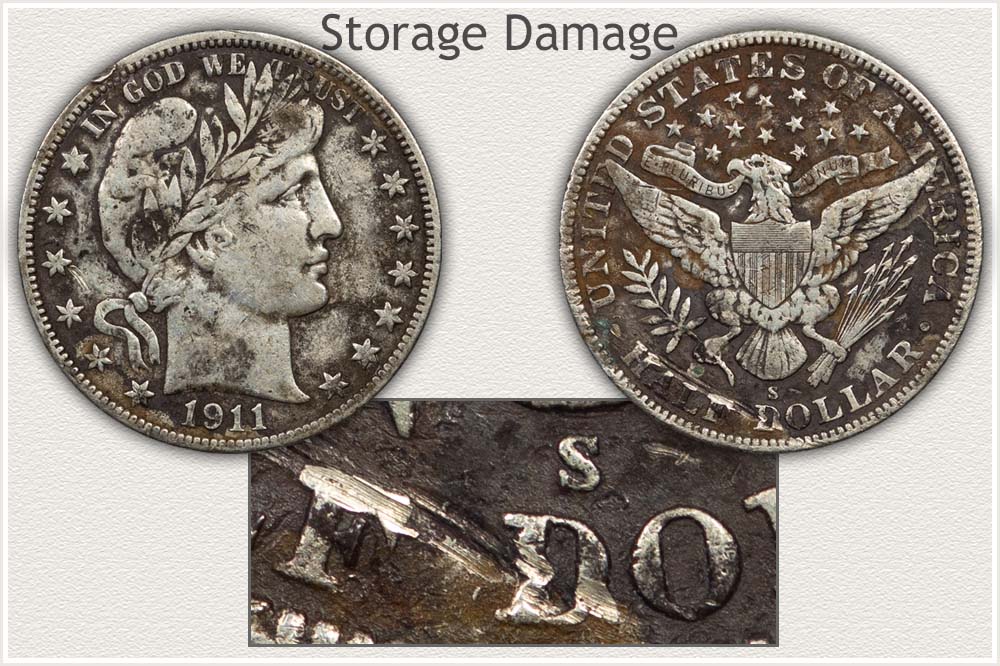 Storage Damaged 1911 Barber Half Dollar
Storage Damaged 1911 Barber Half Dollar
The 1911 Barber half pictured displays an unappealing amount of dark, mottled coloration. Past exposure to humidity caused the surface to develop toning, progressing to corrosion of the surface. A thick coating has accumulated on the fields. An attempt to remove the discoloration has brightened the portrait and devices. Additionally, on the reverse, close to the "S" mintmark, is a large scrap displacing the metal. All combined, giving the coin low eye appeal.
When examining and judging your coins, pleasing eye quality is a strong consideration. Collectors approach coins in the same manner. Adding an appealing coin to collections is the goal. Discoloration and surfaces marred by corrosion quickly eliminate these damaged coins as collectible quality.
A strong second consideration to value is marketability. With demand focused on quality in the coin community, any coin displaying damage and low eye appeal is of low demand - a difficult sell. The only support in price is the underlying silver content of these vintage silver half dollars.
References
U.S. Mint. 1912 U.S. Mint Annual Report
https://nnp.wustl.edu/library/book/324
U.S. Mint. Catalogue of Coins of the United States.
https://nnp.wustl.edu/library/book/554591
Coin Values | CoinStudy Articles
Date by Date
In Depth Barber Half Dollar Values
1892 to 1915
Barber Half Dollar Value | Scarce Low Mintages
Many dates of the Barber half dollar series are scarce because of low mintages, these coins stand out on the full value chart with high premiums. Identify the important factors to narrow how much an old half dollar is worth.
Half Dollar Value | Large Range in Values
Value charts of the different half dollar series. Values have a large range depending on specific date, mint variety, and condition. Each series of half dollars is recognized by images linking to value charts and a process to narrow the range on the chart.
With an image index and value charts listing minimum values, quickly find the value of old coins. Links to in depth coverage of key factors to examine plus close-up grading images help complete an accurate judgment of U.S. coinage.
Silver Coin Values | Minimum Values of U.S. Silver Coins
Barber half dollars were minted during the "silver" age of U.S. coinage. Each Barber half is 90% silver. All have a strong base in the current worth of silver. Review the images and descriptions of other silver era coinage. Using the calculator, find today's current value of silver coins.
Popular Coin Series | Barber Half Dollars
Demand by collectors is the base to collectible value of Barber half dollars. Silver value is quickly surpassed when the supply of coins is scarce. Popularity of the many U.S. coin series is charted, showing the strength of each.
Selling Coins | A Defined Process
First organize your coins to accurately identify each. Placing a narrow value range on the coins prepares for the selling step. Follow the process used by collectors to find dealers suitable to contact from the dealer listings.
★Coin Values Discovery finds 1911 Barber Half Dollar Value and...
U.S. coin value charts plus a step-by-step method, finds a narrow range to how much old coins are worth. Begin here with in-depth coverage of the important features to identify on each coin. Dates plus mint varieties are identified, judging condition with images and video; also, identifying special qualities finds the potential in a box of old coins.
